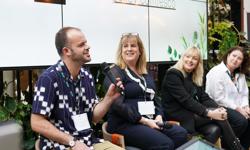In its centenary year, PPA members gathered for their annual conference in the modern setting of the Hilton London Metropole. The underlying agenda for the day: to discuss the key issues facing publishers. An endeavour that can be directly linked to the PPA’s more humble origins as a luncheon club, meeting 100 years ago at the Howard Hotel on London’s Embankment. Whilst the focus may have shifted away from early twentieth century concerns over such issues as paper and ink supplies to more contemporary topics such as digital, multi-channel and audience; there was still plenty to be learned, shared and debated at this year’s conference.
The first keynote of the conference was delivered by Ed Vaizey MP, Minister for Culture Communications and Creative Industries. In his address to PPA members, Mr Vaizey said that the UK’s creative industries were “key to the economy”, and “key to growth”. Mr Vaizey went on to cite the work being undertaken by the Creative Industries Council in supporting the UK’s creative industries in areas like the protection of copyright. Questions over Leveson and taxation of digital content did appear to leave the minister floundering a little, with Mr Vaizey using the expression “above my pay grade” on several occasions.
In a fascinating opening panel discussion entitled, ‘Publishing Futures: The Brand and Beyond’, Wessenden Marketing’s Managing Director, Jim Bilton, shared some headlines from the PPA’s Publishing Futures survey. Mr Bilton told the conference that this year’s findings were “less negative”, and publishers are achieving a “balanced integration of digital and print”. Mr Bilton did have one word of warning, he said: “There is a gap opening up between the leaders and laggers.” Mr Bilton is writing a full article on the findings of the PPA’s Publishing Futures survey for the May / June issue of InPublishing magazine.
During the session, the audience was treated to a number of examples from leading publishing industry experts demonstrating how their own brands are moving beyond traditional publishing boundaries. Nial Ferguson, Group Publishing Director, at Future plc shared some of the successes he has seen with T3 magazine. A tech focused magazine for a tech-savvy audience, Mr Ferguson revealed that “quarter of the revenue is digital business”. This is projected to grow to 50% in 2013. Mr Ferguson shared many of the factors he thought made the magazine a digital success including: the ethos of a digital first product; an understanding that investment would be required to achieve multi-platform support; the importance of video and social media to the overall strategy; creating events with sponsors that allow their audience to get hands-on with products.
In another success story from this session, Will Drew, Editor at Restaurant Magazine, told the audience that what started out as a one-off B2B magazine feature has morphed in a decade to a global reach product in its own right. The World’s 50 Best Restaurants Guide now boasts regional spin-off guides, a full events schedule and some eye-catching sponsors to boot. Noting that at the heart of the venture still remains the printed guide, Mr Drew said “we had great buy in from the industry”, and “sponsors want to be associated with the best”. He went on to explain that integrity and credibility are central to what attracts both the audience and sponsors to the business, and, in his view, to make an events business successful still requires a high degree of human contact.
In the later morning session entitled ‘The Appliance of Science’, PPA members heard from Tom Bureau, Chief Executive at Immediate Media Co. In his presentation, Mr Bureau explained how part of his challenge is moving from a largely print based business to a “content platform and services business”. Mr Bureau revealed that their print business is in growth and that they are building a transactional model with their audiences. A case study involving the Radio Times, showed how they had managed to build a successful extension to their reader offers business in the form of ‘RT Travel’. Built on the trusted Radio Times brand, RT Travel utilises ‘offer embedded content’ to match listening / viewing habits with travel offers eg. ‘Pride and Prejudice: Walk in the footsteps of Miss Bennet and Mr Darcy.’ Central to the venture’s success, Mr Bureau explained, was sourcing trusted and digital savvy partners to work with. Underpinning this endeavour has been a project in association with CACI to make sense of the huge amount of data held by Immediate Media Co and to create an easier to use ‘Single Customer View’ (SCV).
At one of the afternoon tracks entitled, ‘The Business of Events’, PPA members were given an insight into several examples of profitable events businesses. In one slot, Tracey Davies, Managing Director, Retail & Events at EMAP, talked about the changing world of awards. Following a presentation slide headed, ‘logo and a trophy are dead’, Ms Davies went on to explain how sponsor requirements are now so much more complex. Ms Davies said: “Bespoke is becoming the new normal.” A central tenet to any client relationship, Ms Davies explained, is measurability and ROI.
In the same session, Alex Whitson, Director, Conferences, Forums and Digital Events and Video at Haymarket Business Media relayed that digital plays an important part in live events; he said: “Digital gives valuable insight into what is working and what is not.” Mr Whitson went on to say: “What works online doesn’t always work offline.”
In the second keynote of the day, Bruce Daisley, UK Director at Twitter, said he would talk about “how Twitter connects with publishing”. In a mixed presentation combining Twitter related stats such as, 43% of young people say they get their news from social media, and 1% of all Twitter users create 50% of the content, Mr Daisley said: “Twitter has become a powerful distribution tool for content.” Mr Daisley went on to quote an example of the journalist Caitlin Moran’s use of Twitter as being a good source of subscribers for the Times. Mr Daisley told PPA members the adverts that work best for Twitter are ‘native ads’ that look and feel like content, and that he feels this type of ad will be the future for mobile advertising.
In the liveliest session of the day, entitled ‘The New Breed’, a panel of four new recruits, expertly and entertainingly moderated by Tim Arthur, Editor-in-Chief at Time Out, outlined their visions for the foreseeable future. In an opening question asking what the panellists considered to be their biggest challenges, all but one answer included the word ‘digital’. Other considerations included reviewing staff skill sets, audience engagement and creating more brand partnerships. To the question “is print dead?”, Max Raven, Group Revenue Director at Hearst Magazines UK, said: “No, these are very exciting times.” Susi O’Neill, Head of Digital and Content at River Group, replied: “It depends on audience, but print will go south very quickly.”
You can follow the discussion surrounding the PPA’s conference on Twitter using hashtag #ppaconf.












